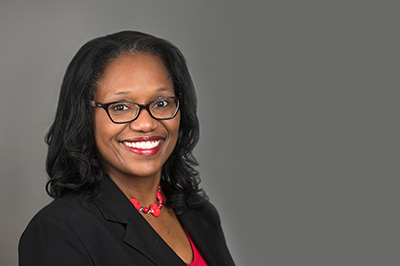ARTICLE FAST FACTS
“I’m Every Woman: Advancing the Intersectional Leadership of Black Women School Leaders as Anti-Racist Praxis”
Author: April Peters-Hawkins, associate professor and associate department chair
Department: Educational Leadership & Policy Studies
Co-author: Angel Miles Nash
Journal: Journal of School Leadership
Publication date: Feb. 5, 2021
Topic: equity in education, school leadership
Overview: Using examples of Black women in education, the article discusses how embracing intersectional leadership, or recognizing how race, gender and other identities intersect and shape experiences, can help historically underserved students from being marginalized.
INTERVIEW WITH THE AUTHOR
What is the purpose of the article?
We talk a lot about Black women and their experiences with leadership, but we really
come back to this notion of how Black, Brown and other marginalized communities are
underserved and how intersectional leadership can address their needs.

What is intersectionality?
Intersectionality is a term popularized by Kimberlé Crenshaw [a professor of law at
Columbia University]. Essentially, our experiences are filtered through our identity
planes in an intersectional way. I don’t just experience things because I’m Black
or a woman. I experience things as a Black woman. Intersectionality acknowledges that
one’s experiences are filtered through identity planes such as race, gender, nationality,
sexual orientation, socioeconomic status, etc.
What is an intersectional leadership mindset like?
At the forefront of an intersectional leader’s mind always is, “How do I make sure
I’m serving all children, particularly those who have been historically underserved?
Because if I don’t meet those needs, I lose those children.”
Along my career as a K-12 practitioner, I’ve met people of every race who have embodied an intersectional mindset and who have not. So, I always tell my doctoral and master’s students, we can’t assume that someone who looks like us embraces those same social justice ideas, cause that’s not true always. And we can’t assume that someone who doesn’t look like us doesn’t embrace those ideas. It’s a case-by-case basis.
How did your own experiences in education contribute to this article?
As a student, I had experiences that I felt marginalized me as a little Black girl
growing up in New Jersey. As I became a teacher, I was passionate about making sure
that no kids had the experience that I had — that no kid was invisible.
During my second year of teaching, I was in a district that had a lot of Black, Brown and poor immigrant children. There was one young Polish girl, and she stood out because most of the kids were kids of color.
I don’t believe her first language was English, and I remember always asking myself, “Is that little girl getting from me what a little Black girl is getting?” Because a kid who looks like me is going to gravitate toward me, and in some ways, I’m going to respond to them. That’s what the research shows. But, as educators, we must push ourselves beyond those spaces.
I’m not an immigrant, English is my first language, but I could relate to potentially feeling invisible or underserved, and I didn’t want her to feel that way. I worked really hard to give her the same thing I was giving everybody else, and I worked very hard to give every kid that — that’s intersectional leadership.
Can you describe your research process?
First, we highlighted the history of Black women educational leaders. These women
led schools at a time in our nation’s history when that was unheard of. We highlighted
those stories to demonstrate how intersectional leadership can be of service to the
community.
It was important to have this information to show that history is not new; this has been happening for a while.
From this, we advanced a new framework for intersectional leadership informed by the research on marginalized students in schools and the history of Black women’s leadership.
What were your most significant findings?
For me, two things were significant. In the course of my research, I discovered that
Lucy Craft Laney was the first Black woman to start a school in this country. I lived
in Georgia for 10 years — I consider it home in many ways — and to learn that Laney’s
achievement happened in Georgia, of all places, was amazing to me. That’s a Herculean
task, even now.
The four tenets at the end of the paper were also significant because they push readers to ask themselves, “Do I embrace intersectionality as a leader? And if not, how can I?”
What are the social implications of this work?
I’m hoping it sparks some reflection, whether it’s among university faculty in educational
leadership, doctoral students or practitioners. I hope they’re inspired by the cultural,
social and political capital that exists not only in the Black community but in many
underserved communities.
Why is this subject important to you?
Because it’s been my life. The most powerful research we can do as scholars is what
we think makes a difference, and the benchmark for that is really our own experiences,
to some degree.
What will you research next?
I’d like to go back and revisit some of the history of Black women in education, and
I’d like to do that juxtaposed to, or in tandem with, other groups who have their
own stories because I think there is strength in those narratives and understanding
those communities better than we do now. I also want to follow up with the end of
the article and think through those tenets and how they might be applied. I’m excited
about the potential for all that.
— By Lillian Hoang